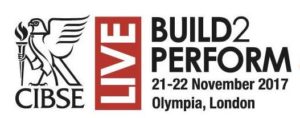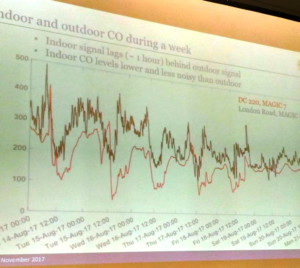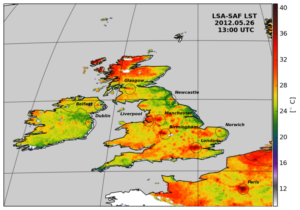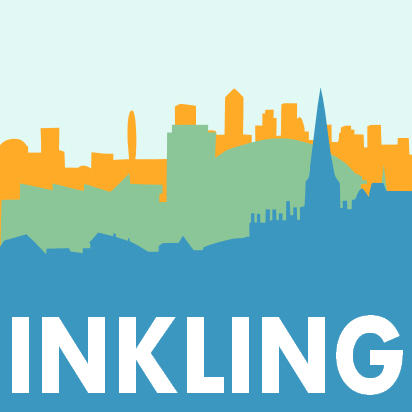Inkling at CIBSE Build2Perform Live
I (Susie) participated in two sessions this year. I spoke on the afternoon of the first day in the session:
‘Designing out domestic overheating risk in challenging urban environments’
The session was chaired by Becci Taylor from Arup.
I opened the session with an introduction to CIBSE TM59 (more here) and highlighted that the majority of questions we have received since this was published have been about the implications for noisy sites; on whether you can open the windows and at what point this precludes adaptive thermal comfort – hence the line-up we invited for this session.
We then heard from Chris Eliades from Arup with two case studies showing how TM59 works in practice.
He was followed by Will South (@wilfredsouth) from Etude who shared ‘3 reasons why you shouldn’t size MVHR systems for summer comfort’. His three reasons are:
- The difference between the ventilation rates needed for air quality, and those needed for cooling is massive. This has knock-on effect of larger ducts, fans, ceiling voids etc. Or, more likely, none of these things happening and noise or fan power issues.
- Even in summer bypass the MVHR will still have a bit of heat recovery, more effective cooling is possible from separate provision
- Energy efficiency. Fan powers creep up and since when was air an efficient way of removing heat? A small amount of mechanical cooling is more efficient than very high ventilation rates, and potentially more future proof.
Acoustics are absolutely everything, keeping MVHR units quiet is essential or people will turn them off.
Will received a good laugh for pointing out that we don’t size WC cisterns for the cooling benefit they provide when they flush and re-fill with cold water so why should we size MVHR for cooling benefit – their job is providing background ventilation.
Next up was Anthony Chilton (@AnthonyChilton) from Max Fordham who spoke about the work that the ANC (Acoustics and Noise Consultants) have been doing to produce AVOG – Acoustics, ventilation and overheating guidance. This document will be published soon and will:
- Help acousticians understand ventilation and overheating
- Set out desirable indoor ambient noise levels
- Provide quantitative, usable guidance – for designers, planners, testing
- Give worked examples/case-studies
The guide will give recommendations for the defining low medium and high noise categories as shown below.
The remaining question is what duration of noise levels in each category is acceptable.. The TM59 team hope to work with the ANC to help define a useful answer to this.
The final speaker of the session, Cassie Sutherland from the GLA talked about the GLA aspirations for London to be the greenest global city.
The intention is for the London Environment strategy (consultation just closed) and the draft New London Plan documents (out for consultation until March 2018) together provide an ambitious and cohesive plan with targets for many aspects including green spaces and air quality.
The London plan makes reference to TM59 and the cooling hierarchy, and Cassie made it clear that the GLA are accepting TM59 reports in support of design stage overheating mitigation strategies.
The session concluded with a Q&A with the panel. Many questions focused on the definition of ‘free running’ and the TM59 team have agreed to reconvene to provide an update with more guidance on this.
I also chaired a session on the second day for the CIBSE Resilient Cities group on City data.
How can innovative use of data sets help us create better buildings?
We had three speakers:
Lee Chapman from the University of Birmingham spoke about Urban heat, big data and critical infrastructure networks.
His talk started with heat mapping in Birmingham, which has gone from having two data points (weather stations), but with NERC funding additional sensors have been added across the city. By Wifi enabling these devices they become part of the Internet of Things (IoT) and much higher resolution temperature mapping has been enabled. This information has multiple applications including directing council gritting operations in winter to those streets most likely to freeze, and monitoring the temperature of electricity sub-stations and the impact on their lifespan so that maintenance can be accurately planned.
Netatmo have developed consumer weather stations sold through the Apple store which provide 4-500 weather station data points across London. https://weathermap.netatmo.com/
Lee finished with some information about one of his current projects CityFlocks which is using tiny wearable sensors attached to city pigeons to do 3D temperature mapping – there were some good tweets about this!!)
 Some initial monitoring data for the internal and external environment around St George’s Circus near Elephant and Castle, London, was shown – e.g. carbon monoxide and carbon dioxide measurements that showed the impact on internal levels of internal and external sources and window opening. Alan also spoke briefly about a preceding project called DAPPLE – Dispersion of Air Pollution and its Penetration into the Local Environment (www.dapple.org.uk)
Some initial monitoring data for the internal and external environment around St George’s Circus near Elephant and Castle, London, was shown – e.g. carbon monoxide and carbon dioxide measurements that showed the impact on internal levels of internal and external sources and window opening. Alan also spoke briefly about a preceding project called DAPPLE – Dispersion of Air Pollution and its Penetration into the Local Environment (www.dapple.org.uk)
More information and case studies on their website.
Lastly Debbie Clifford (@debbieclifford) from the Institute for Environmental Analytics (IEA) spoke about the advantages of utilising data captured from space. These advantages include:
- A wide area of observation
- Same sensor taking all the measurements (no risk of calibration differences)
- Rapid measurements
- Ability to target remote and inhospitable areas
- Continuity – in some cases there are years’ worth of data
- Many sources are open data – free to use (although some become commercially available at the better resolutions)
Data available includes surface temperature mapping across UK which makes cities and roads visible as hot spots.
Finally there was a plug for this free forthcoming event:
‘Space data for environmental and climate financial risk disclosure services’ by Space4Climate and London Climate Change Partnership on 19th Dec 8am in London.
This was a great session giving CIBSE members a view beyond their individual projects to the wider context in which they sit. Accessing and finding innovative uses for the city data available might enable a greater understanding of the environment we are shaping and a more harmonious relationship with the built environment.
General thoughts
I enjoyed the conference. The fact that it was free to attend (rather than paid for as recent years) seemed to improve the diversity of the audience and enabled more people to drop in for at least part of the program. The flip-side of making it free was that the space did not run to enclosed auditoria and the open-plan room, even with microphones provided, made the acoustics more challenging.
I did not manage to attend nearly as many of the presentations as I had intended to due to catching up with other attendees and a head cold. You can catch up with the highlights from other sessions from the tweets sent during the two days (21-22nd Nov) with #Build2Perform.
 Posted by Susie Diamond
Posted by Susie Diamond- Posted in CIBSE, Events, Research, Susie Diamond
 Nov, 30, 2017
Nov, 30, 2017 Comments Off on Inkling at CIBSE Build2Perform Live
Comments Off on Inkling at CIBSE Build2Perform Live

 Susie: 07972 263 676
Susie: 07972 263 676




 Join Us On In.com
Join Us On In.com
